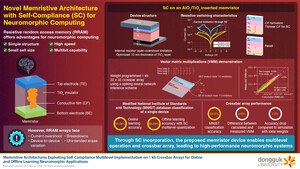Novel Electrode Material Boosts Supercapacitor Performance for Electric Vehicles
SEOUL, South Korea, Feb. 2, 2023 /PRNewswire/ -- Researchers at Dongguk University have designed and synthesized a novel hybrid composite electrode material that significantly enhances the performance of supercapacitors for use in hybrid electric vehicles (HEVs). This composite electrode is comprised of cobalt selenide nanorod-copper selenide polyhedron-decorated over graphene oxide (CCS@GO) and offers unprecedented electrochemical properties. The researchers demonstrated an ecofriendly, economical fabrication, improved charge storage and retention, increased energy and power density attributable to the unique morphology of the electrode material.
Next-generation electronic devices and hybrid electric vehicles (HEVs) need excellent charge storage devices to function well. Currently, majority of the charge storage devices are made from conventional metal sulfide or metal oxide-based supercapacitor electrodes. However, poor electrical conductivity and low energy density are major challenges in the use of supercapacitors, limiting their commercial applications. In contrast, transition metal selenides offer several enhanced electrochemical properties due to their in-built advantageous physicochemical properties including high chemical stability, a narrow bandgap, and low electronegativity that leads to a faster electron-conducting rate than that of metal sulfides and oxides. "A composite formed by the combination of metal selenides and carbon template is a fascinating approach to tune the properties of electrodes for electrochemical applications. Based on this idea, we have designed and constructed a new hybrid composite electrode comprising cobalt selenide nanorod-copper selenide polyhedron-decorated over graphene oxide (CCS@GO), using a wet-chemical strategy", explains Professor Hyun-Seok Kim from the Division of Electronics and Electrical Engineering, Dongguk University, Seoul, South Korea, who has been actively researching 2D materials and nano- and micro-electronics for energy and sensor devices.
In a recent article made available online on August 9, 2021, and published in volume 427 of Chemical Engineering Journal, Prof. Kim and his research team demonstrated that the resultant composite electrode provides abundant space for migration of ions, and allows swift faradaic redox reactions leading to high storage performance in an electrochemical cell. The team attributed the enhanced electrochemical features to the unique morphology and high surface area of the novel electrode material. They established that the synthesized electrode has outstanding electrochemical charge storage and retention properties. Using the electrodes, they constructed an asymmetric supercapacitor device with a capacitance of 192.8 Fg-1 @ 1A g-1; energy density of 54.6 Wh kg-1; power density 700 W kg-1, and capacitance retention of about 82.5% over 10,000 cycles. "We achieved our ultimate goal of constructing an electrochemical supercapacitor with improved electrochemical activity and long-term durability," notes an excited Prof. Kim.
Moreover, the team employed an ecofriendly, cost-effective, energy-efficient, wet-chemical fabrication method with earth-abundant copper and cobalt source materials for developing the new electrodes. Taken together, this development paves the way for user-free, non-flammable energy storage materials for next generation electronic and electrical devices.
Reference
DOI: https://doi.org/10.1016/j.cej.2021.131535
Title of original paper: Unveiling a binary metal selenide composite of CuSe polyhedrons/CoSe2 nanorods decorated graphene oxide as an active electrode material for
high-performance hybrid supercapacitors
Journal: Chemical Engineering Journal
Authors: K. Karuppasamy1, Dhanasekaran Vikraman1, Sajjad Hussain2, Ganesh Kumar Veerasubramani3, P. Santhoshkumar4, Sang-Hoon Lee1, Ranjith Bose5, A. Kathalingam4, Hyun-Seok Kim1
Affiliations:
1Division of Electronics and Electrical Engineering, Dongguk University-Seoul, Seoul 04620, Republic of Korea
2Department of Nanotechnology and Advanced Materials Engineering, Sejong University, Seoul 05006, Republic of Korea
3Department of Chemical Engineering, Hanyang University, Seoul 04763, Republic of Korea
4Millimeter-Wave Innovation Technology (MINT) Research Center, Dongguk University-Seoul, Seoul 04620, Republic of Korea
5Department of Chemical Engineering, Khalifa University, Abu Dhabi 1277
*Corresponding author's email: [email protected]
About Dongguk University
Website: http://www.dongguk.edu/mbs/en/index.jsp
Contact:
Jiyoung Choi
82 2 2260 3067
[email protected]
SOURCE Dongguk University

WANT YOUR COMPANY'S NEWS FEATURED ON PRNEWSWIRE.COM?
Newsrooms &
Influencers
Digital Media
Outlets
Journalists
Opted In






Share this article